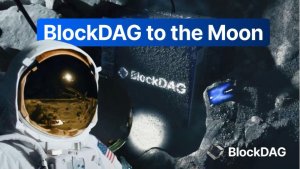Sweat Economy’s Oleg Fomenko on upcoming launch of Move-to-Earn app in the US
With the crypto winter’s biggest hurdles seemingly behind us as the prices of Bitcoin et al. climb the charts again, the Web3 economy is preparing for the next phase.

Now, more than ever, what matters the most is utility. And that’s where a few blockchain-powered apps claim their stage. One of them is Sweat Economy, which has been around promoting an “economy of movement” to over 130 million users in Web2 and Web3 since 2016 via the SweatCoin app.
The company deploying a Move-to-Earn model has plans to launch its new product, Sweat Wallet, in the United States in September 2023. Outside of the US, the wallet has over 13 million users and features a staking and rewards club, fiat on-ramp, and is in the process of adding NFTs and games.
FinanceFeeds spoke with Oleg Fomenko, Co-Founder of Sweat Economy, to learn more about the upcoming launch in the US, the Move-to-Earn model, $SWEAT tokens and how they incentivize a healthier lifestyle.
Can you provide insight into the regulatory process that allowed you to bring Sweat Economy to the US and how you will operate this time?
The Sweat Wallet app is not available in certain markets due to regulatory restrictions, but we stay updated on regulatory requirements in each region. We’re working hard on compliance and bringing Sweat Wallet to the United States in September 2023. In most basic terms our entry into the US is a part of our decentralisation process with our community demanding this action from us day in and day out. We will be entering the US as if we were regulated – providing necessary transparency and disclosures, but most importantly without negatively affecting the US retail. Our long-term objective is to be regulated in the US and we will welcome constructive dialogue whenever it arises.
How can Move-to-Earn help crypto adoption?
There is an overused adage in web3 of “the next billion people”. Whatever your attitude towards it is, the reality is that the growth of our industry will have to come from wider adoption of crypto and in order for that to happen we need to deliver on three things:
- Mass-market use cases that are simple to understand and engage with. Our tokenization of physical activity and turning it into the currency of exchange is extremely simple to understand and engage with use cases.
- Simple and elegant User Experience (UX) developed from first principles for humans, not degens (e.g. none of the upfront barrier of seed phrases before seeing any value in the product, etc.) and our 8 years of experience delivering amazing UX to tens of millions of users with Sweatcoin app puts us into a great position to deliver on this
- Allow users to enter without initial investment and “Move-to-earn” allows our users to literally “walk into crypto” removing barriers to adoption and engagement.
According to your website, over 100 million people already use the app. Is the move-to-earn model for users more than regular health & fitness apps? What benefits have users experienced?
The Sweatcoin(Web2) app acts as a step validator and rewards users with sweatcoins (in-app points), users can then redeem rewards such as vouchers, gift cards, and electronic devices from partnered brands. As opposed to traditional health & fitness apps, we incentivize users to become more physically active.
With our transition into Web3, we have launched the Sweat Wallet(Web3) app and $SWEAT token to provide even more incentives to users. They can earn $SWEAT tokens with their steps, opt-in to prize draws, get access to Web3 education content, play the Sweat Hero NFT game, etc. Users can enter the Web3 space without initial investment and in-depth knowledge of crypto.
How has user acquisition been lately, and what are the expected future expectations?
Our biggest user acquisition came from Sweatcoin, our Web2 app, which has gathered 130M+ users currently and the number is still growing. It is now the most popular health and fitness app in 58 countries in the world.
We created a massive funnel to smoothly acquire and onboard Sweatcoin(Web2) users who’re into fitness and would like to earn crypto into our Sweat Wallet (Web3) app.
There is an organic growth of 10k+ sign-ups every day in Sweat Wallet and we haven’t even started our aggressive paid strategy! The results are impressive. It shows that users are ready for a low-barrier entry into the Web3 space.
As we roll out more features and utilities in the Sweat Wallet app, we will ensure an optimal level of engagement as well as sufficient enough level of monetization to support our business model. We expect to see exponential growth in user numbers.
Mass-market use cases with a focus on mobile like us will be the key drivers of growth in the industry. It is not going to come from funky money use cases. It is not going to come from desktop web either. The future is mobile!
The Web2 Sweatcoin app has been around since 2016. How will you onboard users to the Web3 app?
Sweatcoin has 130M+ users around the world. We have onboarded 13M+ users into our Sweat Wallet (Web3) app at our Token Generation Event in September 2022. Users can earn $SWEAT tokens with up to 5k steps every day and enter prize draws to win tangible rewards. We have also introduced other utilities such as on-ramp, staking, and Learn & Earn education content. In addition, our Sweat Hero NFT game is launching soon in the Sweat Wallet app.
We will continue to introduce more utility within the Web3 ecosystem to educate Web2 users and provide a seamless and fun experience to onboard them into the Web3 space.
What incentives do you use to promote healthier behaviors?
As long as users have the Sweatcoin and Sweat Wallet apps, they earn $SWEAT tokens every day with their movements without buying an NFT or any initial investment. With $SWEAT tokens, any users can opt in to prize draws and win tangible rewards such as Nike gift cards, Apple watches and iPhones, vacations, event tickets, etc.

To encourage movement in perpetuity, we will introduce an inactivity fee. As a “loss aversion” mechanism, it will help ensure that people remember that it is not a one-off burst of activity that makes one healthier but a consistently high level of physical activity on a daily basis. The DAO will charge users a fee if they stop engaging with the app or cease to be active. The inactivity fee will be a token sink mechanism that DAO will be able to vote on the use of. In case of its burn, it will directly reduce the circulating supply.









